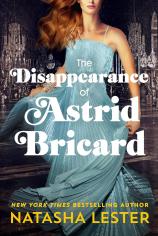The Disappearance of Astrid Bricard
Review
The Disappearance of Astrid Bricard
In the world of fashion, there are designers and muses, assistants and seamstresses. Then, once in a generation, there’s a woman like Astrid Bricard.
The daughter of the notorious Mizza Bricard, muse to the Christian Dior, Astrid has fought long and hard to shed her mother’s fame and be perceived as her own woman of worth. That is not easy when you aim to wow the very same industry that used and exploited your mother. Known for her lack of panties and excess of lovers, Mizza inspired entire lines of couture, but she was remembered much more for being a party girl who turned away from expectations and upended society’s predestined role for her as a woman in the arts.
Astrid is aware that Mizza's journey was not an easy one, but she’s more consumed by the ways in which her mother’s legacy has overshadowed her own journey. From the teasing gazes of men who ask if she inherited Mizza's hatred of undergarments to her classmates at the Fashion Institute of Technology, who remain convinced that Astrid was admitted with a prestigious scholarship because of her mother’s reputation and not her own talent, everyone seems set on underestimating her. Luckily for Astrid, their opinions only push her to work harder and design memorable, glamorous dresses the likes of which the fashion world has never seen before. And then she meets Hawk.
"Lester is a keen observer of each era she writes, weaving in everything from the politics to the fashion. Her characters absolutely leap off the page, each of them wielding dressmaker shears and a needle."
A fashion student wunderkind, Hawk is famous for doing the one thing that every FIT professor warns their students against doing: leaving school and immediately opening his own studio, rather than aiming for an internship with one of the top designers or (heaven forbid) a lesser known designer. Hawk is charming and swoon-worthy, but more than that, he believes in Astrid. Despite her no-nonsense approach to school and love, the two quickly hit it off. Their passion is one that they’re keen to ignore, but it attracts the eye like a sculptural dress or feather boa.
One night, while Astrid is wearing one of Hawk’s most controversial, revealing designs, the two are captured on camera dancing on a table, and history is made. Their photo is everything the 1970s is: flashy, heady and glamorous, and it becomes indicative of an era in the same way that the Rolling Stones or Fleetwood Mac are. As their partnership soars, they are invited to the 1973 Battle of Versailles, a competition between American and French designers to determine who will earn their country the title of “fashion capital of the world.” But rather than presenting her white column dress, Astrid disappears, leaving nothing but her final creation, smeared with crimson blood.
In present day, Blythe Bricard is nearing the end of her rope. Her recent divorce has left her spent, financially and emotionally. Although she has always dreamed of designing ecofriendly clothing, she instead has found herself costuming popular television shows. With the reputations of her grandmother and mother looming over her, Blythe can see why the papers and magazines call her a disappointment to her family name, even as they constantly seek her out for revelations about her mother and what she thinks really happened that night. Rumors of a drug deal gone wrong, a competition with a fellow classmate and even a staged disappearance have hounded Blythe for years. But wherever she went, Blythe knows only one thing: Astrid Bricard didn’t care enough about her daughter to stay, and that’s enough to forget her forever.
That is, until Blythe is approached with the deal of a lifetime. A prominent fashion dealer is interested in reviving Astrid’s sole fashion line, and they want Blythe to head the project. This would mean merging her designs with those of her mother and reminding the world of Astrid’s talent. But her mother’s legacy is painful, and growing up under the mantle of her panty-less grandmother and short-skirted mother has positioned Blythe right in the middle of a whole lot of misogyny. Sex --- and her like or dislike of it --- has been all anyone thinks about when they meet the heir to the Bricard name, and she’s hesitant to hitch her wagon to a publicity gimmick.
But the money is alluring, as is the chance to do something for herself. When she learns that a relative has been studying Astrid’s disappearance and has discovered certain holes in the story, it becomes obvious that it is time to set the record straight once and for all --- both to save the Bricard name and to put Astrid’s mystery to rest…and maybe claim something for herself at the same time.
Natasha Lester has penned a spellbinding, captivating mystery that is both a sartorial adventure through the ages and a scathing critique of misogyny and how it confines and oppresses women. While Mizza is based on a real historical figure, Astrid and Blythe are Lester’s own creations, and the story truly soars with their plotlines.
Lester is a keen observer of each era she writes, weaving in everything from the politics to the fashion. Her characters absolutely leap off the page, each of them wielding dressmaker shears and a needle. A deft, stylish writer, Lester is able to trace the tumultuous highs and lows of her characters in a way that is as graceful as it is informative. Each of them are completely fleshed out and defined by their settings, making this story instantly immersive and atmospheric.
THE DISAPPEARANCE OF ASTRID BRICARD is, shamefully, my first Natasha Lester book, but rest assured that I’ll be ordering her backlist as soon as this review is done.
Reviewed by Rebecca Munro on February 2, 2024
The Disappearance of Astrid Bricard
- Publication Date: July 9, 2024
- Genres: Fiction, Historical Fiction, Women's Fiction
- Paperback: 480 pages
- Publisher: Forever
- ISBN-10: 1538706962
- ISBN-13: 9781538706961




